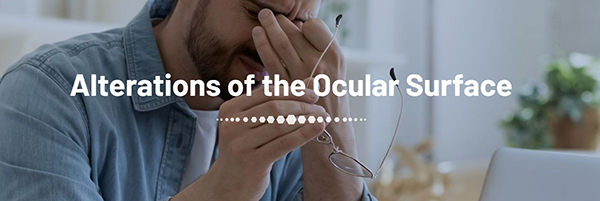Alterations of the Ocular Surface

The ocular surface is defined as an anatomic and functional unit where glands, nerves, conjunctiva, cornea, eyelids and lacrimal film are anatomically and functionally interrelated parts of a dynamic and homeostatic equilibrium.
Many pathological conditions, including infections, inflammation, dry eye disease, etc. can affect one or more parts of the eye, thus causing the loss of homeostasis in the entire ocular surface system.
The most common cause of an alteration of the ocular surface is Dry Eye Disease (DED).
Traditionally, 2 different types of DED can be identified:
Recent evidence, emerging from the international consensus meeting “Dry Eye Workshop 2 (DEWS2) in 2017, supports a new DED definition - based on the pathophysiology - stating that aqueous deficiency or evaporative dry eye can occur together.
“Dry eye is a multi-factorial disease of the eye surface, involving a loss of homeostasis in the lacrimal film, associated with ocular symptoms. Instability and hyperosmolarity of lacrimal film, inflammation and damage on the ocular surface, besiders the neurosensorial alterations, play a role in the disease onset”.
DED is one of the most common conditions in ophthalmology: it affects people of any age, particularly adults > 50 years (~ 20% are affected by the disease). It is considered an emerging illness because is related to an increase in the etiological factors which are responsible for its onset, such as fine atmospheric pollutants, widespread use of screen devices and certain types of treatment and surgery, along with a greater overall life expectancy.
The main reported symptoms are eye discomfort, foreign body sensation or sand presence in the eye, insect bite sensation and burning.
Several artificial tears are largely recommended by ophthalmologists (eyedrops, ophthalmic ointments and gels) to reduce symptoms and eye discomfort during day and night. Cortisone eyedrops are used when an anti-inflammatory effect is required. Other medical options, such as punctal plugs and pulsated light, are available for specific clinical conditions.